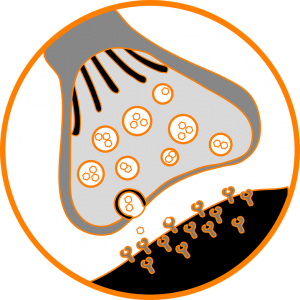It is well known that the nervous system is capable of change. One way that change occurs is through the strengthening or weakening of connections between nerve cells; a process termed synaptic plasticity. In the laboratory, we can produce synaptic changes using stimulation techniques that activate various parts of the nervous system. One technique we have developed in humans is the delivery of repeated pairs of stimuli to presynaptic nerve cells of the corticospinal pathway (one of the pathways for the control of voluntary muscle activity), and the postsynaptic motoneurones they synapse onto. This technique is termed paired corticospinal-motoneuronal stimulation (PCMS). Previous work from our lab has shown that this technique can strengthen or weaken the connections between corticospinal nerve cells and motoneurones, depending on the specific interval between the two stimuli (Taylor and Martin 2009). We have also shown that 100 pairs work better than 50 pairs (Fitzpatrick et al. 2015; see previous blog post), and that motor performance can be enhanced (Taylor and Martin 2009, D’Amico et al. In Press). The technique has also shown promise in a group of spinal cord injured participants, who had increases in hand muscle responses and improvements in a test of manual dexterity (Bunday and Perez 2013). The exact mechanisms of the PCMS-induced changes are not yet known, and our current study (Donges et al. In Press) aimed to determine whether the technique depends on a certain type of receptor that is responsible for synaptic plasticity at several other locations within the nervous system. These receptors are called N-methyl D-aspartate receptors (NMDA receptors), and they can be inhibited using a compound called dextromethorphan.
WHAT DID WE FIND?
In our two-day study, twelve participants were given dextromethorphan or a placebo in random order. Muscle responses elicited by spinal cord stimulation were increased after PCMS on the placebo day (~130% of baseline), but not on the dextromethorphan day (~90% of baseline), suggesting that dextromethorphan suppressed the PCMS-induced strengthening of synapses.
SIGNIFICANCE AND IMPLICATIONS
The lack of effect of PCMS on the dextromethorphan day indicates that when NMDA receptors are inhibited, facilitation cannot occur. Thus, the induced plasticity of the corticospinal pathway may be NMDA receptor-dependent. Pharmacological interventions that enhance NMDA receptor activity may therefore be good candidates for improving the ability of PCMS to enhance descending drive to muscles.
PUBLICATION REFERENCE
Donges SC, D’Amico JM, Butler JE, Taylor JL. The involvement of N-methyl-D-aspartate receptors in plasticity induced by paired corticospinal-motoneuronal stimulation in humans. J Neurophysiol. In Press, DOI: 10.1152/jn.00457.2017.
If you cannot access the paper, please click here to request a copy.
KEY REFERENCES
Bunday KL, Perez MA. Motor recovery after spinal cord injury enhanced by strengthening corticospinal synaptic transmission. Curr Biol 22: 2355-2361, 2012.
D’Amico JM, Donges SC,Taylor JL. Paired corticospinal-motoneuronal stimulation increases maximal voluntary activation of human adductor pollicis. J Neurophysiol. In Press, DOI: 10.1152/jn.00919.2016.
Fitzpatrick SC, Luu BL, Butler JE, Taylor JL. More conditioning stimuli enhance synaptic plasticity in the human spinal cord. Clin Neurophysiol 127: 724-731, 2016.
Taylor JL, Martin PG. Voluntary motor output is altered by spike-timing-dependent changes in the human corticospinal pathway. J Neurosci 29: 11708-11716, 2009.
AUTHOR BIO
 Dr. Siobhan Dongés is a postdoctoral research fellow at Neuroscience Research Australia (NeuRA). Her research involves the use of a variety of non-invasive stimulation techniques to test and induce plasticity in human motor pathways.
Dr. Siobhan Dongés is a postdoctoral research fellow at Neuroscience Research Australia (NeuRA). Her research involves the use of a variety of non-invasive stimulation techniques to test and induce plasticity in human motor pathways.

